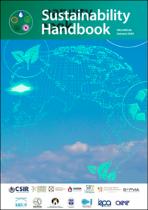JavaScript is disabled for your browser. Some features of this site may not work without it.
- ResearchSpace
- →
- Research Publications/Outputs
- →
- Books
- →
- View Item
| dc.contributor.author |
De Jager, Peta

|
|
| dc.date.accessioned | 2024-03-19T08:03:46Z | |
| dc.date.available | 2024-03-19T08:03:46Z | |
| dc.date.issued | 2024-01 | |
| dc.identifier.citation | De Jager, P. 2024. <i>Sustainability Handbook Volume 8</i>. s.l.:Alive2Green. http://hdl.handle.net/10204/13649. | en_ZA |
| dc.identifier.isbn | 978 0 620 45240 3 | |
| dc.identifier.uri | http://hdl.handle.net/10204/13649 | |
| dc.description.abstract | Given that cement is the third most utilized material following sand and water and its manufacture contributes an estimated 6% of global anthropogenic carbon dioxide emissions, there is a need to consider recyclability, life cycle environmental impact, and economic feasibility. Materials science takes front stage in this volume with research and industry investigating technologies which can reduce its negative impacts. Amongst contemporary challenges faced by concrete, is the durability of the material in infrastructure. Geopolymers represent a valuable addition to the expanding array of cementitious materials, which serve as primary inputs in concrete production. UCT joins hands with the CSIR to build on international research in this field, testing mineral acid resistance in both static and dynamic conditions, for - amongst others - sewer applications. Dumani and Mapiravana report on their cradle-to-gate environmental life cycle assessment of limestone calcined clay cement (LC3), which shows it to be a very promising alternative to Ordinary Portland Cement. In other work, in quantifying the environmental impacts of a sustainable concrete mix for a block paving system, researchers find that replacing cement with fly ash, beyond 35%, as stipulated in the national cement specification for common cements, presents a significant opportunity to reduce environmental impacts without (necessarily) compromising strength. | en_US |
| dc.format | Fulltext | en_US |
| dc.language.iso | en | en_US |
| dc.publisher | Alive2Green | en_US |
| dc.relation.uri | https://sustainability-handbook.alive2green.co.za/magazine/vol8/ | en_US |
| dc.subject | Green buildings | en_US |
| dc.subject | Construction materials | en_US |
| dc.subject | Sustainable buildings | en_US |
| dc.title | Sustainability Handbook Volume 8 | en_US |
| dc.type | Book | en_US |
| dc.description.edition | Volume 8 | en_US |
| dc.description.pages | 190 | en_US |
| dc.description.placeofpublication | Cape Town | en_US |
| dc.description.cluster | Smart Places | en_US |
| dc.description.impactarea | FBI Management Area | en_US |
| dc.identifier.apacitation | De Jager, P. (2024). <i>Sustainability Handbook Volume 8</i>. Alive2Green. http://hdl.handle.net/10204/13649 | en_ZA |
| dc.identifier.chicagocitation | De Jager, Peta. <i>Sustainability Handbook Volume 8</i>. n.p.: Alive2Green. 2024. http://hdl.handle.net/10204/13649. | en_ZA |
| dc.identifier.vancouvercitation | De Jager P. Sustainability Handbook Volume 8. [place unknown]: Alive2Green; 2024.http://hdl.handle.net/10204/13649 | en_ZA |
| dc.identifier.ris | TY - Book AU - De Jager, Peta AB - Given that cement is the third most utilized material following sand and water and its manufacture contributes an estimated 6% of global anthropogenic carbon dioxide emissions, there is a need to consider recyclability, life cycle environmental impact, and economic feasibility. Materials science takes front stage in this volume with research and industry investigating technologies which can reduce its negative impacts. Amongst contemporary challenges faced by concrete, is the durability of the material in infrastructure. Geopolymers represent a valuable addition to the expanding array of cementitious materials, which serve as primary inputs in concrete production. UCT joins hands with the CSIR to build on international research in this field, testing mineral acid resistance in both static and dynamic conditions, for - amongst others - sewer applications. Dumani and Mapiravana report on their cradle-to-gate environmental life cycle assessment of limestone calcined clay cement (LC3), which shows it to be a very promising alternative to Ordinary Portland Cement. In other work, in quantifying the environmental impacts of a sustainable concrete mix for a block paving system, researchers find that replacing cement with fly ash, beyond 35%, as stipulated in the national cement specification for common cements, presents a significant opportunity to reduce environmental impacts without (necessarily) compromising strength. DA - 2024-01 DB - ResearchSpace DP - CSIR KW - Green buildings KW - Construction materials KW - Sustainable buildings LK - https://researchspace.csir.co.za PY - 2024 SM - 978 0 620 45240 3 T1 - Sustainability Handbook Volume 8 TI - Sustainability Handbook Volume 8 UR - http://hdl.handle.net/10204/13649 ER - | en_ZA |
| dc.identifier.worklist | 27691 | en_US |






